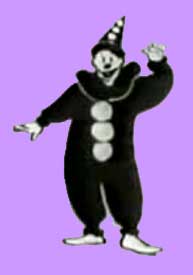 The Fleischer brothers Max, Dave, & Leonard started out in the 1920s with silent cartoons & one of their biggest stars was Koko the Clown. He starred in a great many silent "Inkwell Imps" episodes, usually seven minutes long, with many surrealist gags but rarely much of a story, more just "themes" on which to hang the gags.
The Fleischer brothers Max, Dave, & Leonard started out in the 1920s with silent cartoons & one of their biggest stars was Koko the Clown. He starred in a great many silent "Inkwell Imps" episodes, usually seven minutes long, with many surrealist gags but rarely much of a story, more just "themes" on which to hang the gags.
Many of these charming little films began with live action of Max in his art studio drawing his characters, who would come to life. The rest will either consist of Koko & occasional friends, especially the rabbit-like dog Fitz, adventuring in the "real" world, or in the cartoon they self-generate once Max gets them started.
Among the earlier Out of the Inkwell cartoons is Modeling (1921). This was the Fleischer brothers' first film release after leaving Republic to become an independent studio. Max Flesicher is shown at work in his studio. He opens one of those old-fashioned India ink bottles, dips the nib of his fountain pen within, then draws some blobby shapes on a piece of paper.
He lifts the paper & dumps the circular lines back into the fountain pen, then squeezes the pen so that it squirts out gobs of ink onto the page. These turn into Koko the Clown, although at this stage in his history he was known only as "the clown."
Max squirts some more ink, & the blobs hit the page turning Koko's white clown costume black. Koko's hat gives a twirl. He waves to Max & a title-card reads, "Why don'tcha use fresh ink when you draw me? I've got no more pep than a snail under ether." Though weary with yawns & sleepiness, Max pokes him & makes him do a few easy acrobats.
Meanwhile, elsewhere in the studio, a dapperly dressed fellow with a gigantic hooked nose (probably Dave Fleischer wearing nose appliance) has arrived & seated himself to be used as a model for shaping a claybust. The sculptor (animator Roland "Doc" Crandall) works on the bust separate from Max's sporting with Koko.
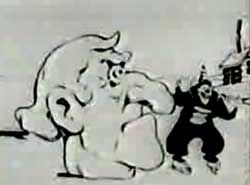 The model complains when he realizes the bust looks just like him (he apparently wanted to look less ugly). Max says he'll be over to help "as soon as I put some energy in this clown." He draws skates on Koko's feet & a scene with a frozen pond. The model complains when he realizes the bust looks just like him (he apparently wanted to look less ugly). Max says he'll be over to help "as soon as I put some energy in this clown." He draws skates on Koko's feet & a scene with a frozen pond.
Max leaves the drawing of Koko, who flails about with poor skating skills, slowly improving. Max goes to help on the bust.
Koko's flailing incorporates extremely realistic motion because Max had invented rotoscoping, & Koko was animation's first rotoscoped character. For special scenes he woudl be drawn over film of Dave Fleischer acting out the movements.
Several amusing gags involve Koko trhing to sculpt the ugly man in ice or snow, & battling with a polar bear, & a cow shows up in Koko's universe to fall through the ice & suchlike. Much of it's very amusing even if rather random.
Koko skates off the page, out of his drawn world into the Inkwell Studio. He skates up the pedistal where the bust is being made & finishes it himself. The three live-action players watch a loose piece of clay crawl around the floor like a slug, then get in a bit of a fight, before Koko leaps back into the inkwell.
This groundbreaking blend of stop-motion animation, live action, & animation, is very effective. The excellent & apropos music for this & other early Koko silent cartoons was written by Winston Sharples & added in the 1950s when these were syndicated to television.
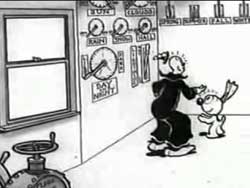 The "out of the inkwell" cartoons later became "the inkwell imps," as with Koko's Earth Control (1928) is one of the strangest of a very strange load of cartoons.
The "out of the inkwell" cartoons later became "the inkwell imps," as with Koko's Earth Control (1928) is one of the strangest of a very strange load of cartoons.
It begins like most Inkwell Imps 'toons with Max Fleischer in his studio drawing. He dips his pen's nib into the inkwell & draws the Earth, then puts Koko & his dog on top of the globe & starts them running.
As they run, the earth spins under their feet. They arrive at an electrified building that says on its front "Control of the Earth." Within, they see nobs & dials & levers & wheels that control such business as "Sun" "Clouds" "Day & Night" & so on.
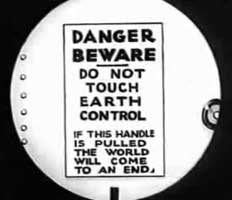 The dog Fitz gets dot-dot-dots from his eyes to a sign that reads alarmingly "Danger Beware Do Not Touch Earth Control. If this handle is pulled the world will come to an end." Fitz is eager to give it a try. The dog Fitz gets dot-dot-dots from his eyes to a sign that reads alarmingly "Danger Beware Do Not Touch Earth Control. If this handle is pulled the world will come to an end." Fitz is eager to give it a try.
Koko on the other side of the room turns on "Rain" then turns it off & is quite thrilled. He tries the dial for "Day &[ Night" & is pleased with that to.
But when he sees Fitz attempting to move the end-of-the-world handle, he gets distressed, & a battle breaks out with Fitz trying to test if the world can really be destroyed with the lever, & Koko trying to preserve the world.
Eventually Fitz wins & soon the moon, sun, & earth undergo upheavels of comic destruction. When the Earth Max had drawn at the beginning of this adventure is destroyed, Koko is tossed out of the cartoon into Max's studio.
Still terrorized, he flees by a window & discovers there are upheavels in the "real" world too, with beautiful stop motion scenes of destruction which for 1928 was a pretty advanced portrayal science fiction catastrophe.
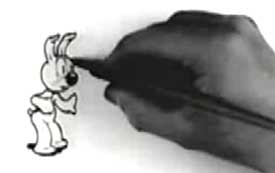 Koko's Courtship (1929) as typical of these films begins with live action footage of Max Fleischer doing a drawing of Koko who comes to life. Max roles up the drawing & gives it to a fat child & tells him to rush it to Inkwell Studios, & fast.
Koko's Courtship (1929) as typical of these films begins with live action footage of Max Fleischer doing a drawing of Koko who comes to life. Max roles up the drawing & gives it to a fat child & tells him to rush it to Inkwell Studios, & fast.
Off goes the fat kid whose name is Skinny, while Max draws Fitz the dog & tells him to run after Skinny & make sure he doesn't waste any time. Fitz jumps off the page & runs after the kid, drawn against real city street scenes.
The cartoon & live action mix appeallingly as teency Fitz strolls along watching the sundry ways Skinny wastes time, watching ditchdiggers, watching a bit of a baseball team.
While flirting with a girl in the park, because he's interested in her ice cream cone, Skinny drops the drawing of Koko, who leaps to life on the page & creates a scene for himself of flirting in the park, in order to show Skinny how it's done.
Fitz arrives & leaps into the scene & messes up Koko's routine before arranging some animated gags of his own, including the creation of a trolly on which Koko tries to make time with the girl, who bites him & beats him up.
It's really not one of the better Inkwell Imp films, & it inexplicably makes Koko & his dog look like mortal enemies.
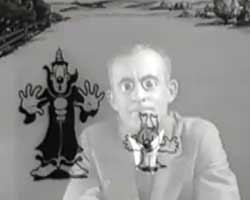 The live action opening of Koko's Hypnotism (1929) shows a man studying hypnotism. He hypnotizes his dog to be lighter than air & the dog floats about. The hypnotic system involves putting plastic eye-cups with eyeballs painted on them over one's own eyes, to look very mesmeric.
The live action opening of Koko's Hypnotism (1929) shows a man studying hypnotism. He hypnotizes his dog to be lighter than air & the dog floats about. The hypnotic system involves putting plastic eye-cups with eyeballs painted on them over one's own eyes, to look very mesmeric.
Max puts the eyeballs back in & hypnotizes Fitz & Koko out of the inkwell & onto the sheet of paper. He makes Koko believe he's a squirrel, & Fitz a walnut, so that Koko tries to eat Fitz. Max breaks the spell just before Fitz gets killed.
More such gags follow, none of them especially good, just Max being cruel to his two characters & laughing at their pain & humiliation. When he gets up from his drawing desk & leaves, Koko & Fitz have more interesting adventures with Max gone, involving two mice in a boot & a witch who teaches Koko the secrets of hypnotism.
He's now prepared to get revenge on Max, who deserves it. He convinces Max he's a high-diver at a pool. Max takes his clothes off, climbs to the highest spot he can arrange, & jumps into a fishbowl getting his head stuck in it. Fitz & Koko then return to the inkwell.
The revenge was better than the initial cruelty but none of its all that good. The scenarios are a bit more original than usual for these silent cartoons, & the mixture of live action & animation works especially well.
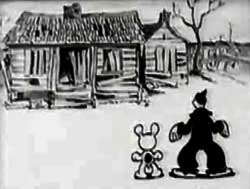 Another "Inkwell Imps" silent era cartoon, Koko's Reward (1929) opens like most Koko cartoons with live footage of Max Fleischer drawing the key characters. This time Max's impatient little daughter is with him. She wants to be taken to the playground (actually Coney Island), but Max has to finish one of his magic drawings in order to kickstart the next cartoon.
Another "Inkwell Imps" silent era cartoon, Koko's Reward (1929) opens like most Koko cartoons with live footage of Max Fleischer drawing the key characters. This time Max's impatient little daughter is with him. She wants to be taken to the playground (actually Coney Island), but Max has to finish one of his magic drawings in order to kickstart the next cartoon.
He draws Koko with the bunny-dog Fitz with their heads on the wrong bodies. Fitz thinks its hysterical but Koko gets annoyed & switches heads properly.
He draws a country shack setting for Koko & his small pal. Meanwhile, without Max noticing, we see the little girl spill some clear ink-lacquer & rubs it on herself, because it's the magic ingredient to ink. She immediately turns into a tiny cartoon girl & climbs down the chair leg.
When Max finds his daughter missing, he asks Koko & the bunny-dog to help find her. They jump out of the drawing, leap to the window, & begin looking around the city for the tiny cartoon girl, checking out Coney Island of course.
But the little girl was hiding under the desk, where she's frightened by a full-sized cartoon rat, & climbs up the table leg to Max's desk. She jumps into Max's drawing of the rural cabin.
The story cuts back to the live footage of rides at Coney Island & the two little cartoon characters jumping on rides & climbing on children, & then back to the little girl in the drawing of the rural cabin. Finally Koko & his pal are tossed by one of the rides back through Max's window & into the drawing of the rural cabin.
Several minor gags occur, involving the appearance of a ghost, Koko getting naked, Koko & bunny-dog vanishing & reappearing, a dancing skeleton, & so on, just a lot of general nonsense that furthers no particular story, though there are some lovely weird sequences that end with the monsters turning out to be the little girl in disguise.
She turns back into herself & laughs & laughs. Koko & Fitz get their reward from the girl, which are kisses before they're put back in the inkwell. This is a spectacular piece of b/w animation & a nice look at Coney Island besides.
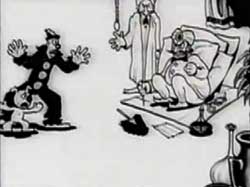 The Inkwell Imps are back, in Koko's Harem Scarem (1929). It begins with live-action of a ridiculously clad Turkish sultan smoking from a hooka, Considering the events that will unfold, could be the hooka contains wacky tobakky. He's impatient for the arrival of some "boob" who has promised treasure.
The Inkwell Imps are back, in Koko's Harem Scarem (1929). It begins with live-action of a ridiculously clad Turkish sultan smoking from a hooka, Considering the events that will unfold, could be the hooka contains wacky tobakky. He's impatient for the arrival of some "boob" who has promised treasure.
The "boob" arrives with a treasure-box he found after searching the whole world. He found it in America. "Gimme gimme" says the Sultan (if you can lip-read a silent cartoon). The sultan opens the box & it contains an inkwell. Popping the top, out climbs Koko the clown & Fitz the dog, whom the Sultan immediately beheads, then leaves, quite proud of himself, Allah alone knows why.
Left alone, the cartoon characters put their heads back on & set out to explore the animated world of the sultan, via one of Max's drawings pinned to the sultan's wall, Allah alone knows why. They see a snake charmer magician, who teleports Fitz to the palace.
Koko goes to the palace in search of Fitz & ends up peeping through a keyhole at the harem queen, chased around by a black guard who is an abominably racist stereotype with a giant switchblade, but overcomes him by getting him interested in a game of craps & the black gard ends up shining shoes. Not funny.
Koko in a burka does a harem dance for the sultan who falls in love with him. He finds Fitz & throws off his disguise, which quite annoys the sultan. It ends with a chase all the way back to the inkwell.
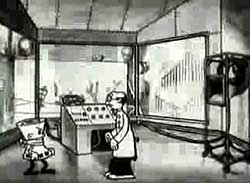 With the arrival of new technologies that permitted sound films, the Fleischers' Inkwell Studios was among the first to begin to embrace sound. Finding His Voice (1929) was one of their early experiments, announcing up front that it is "an animated cartoon syncronized to voice & sound," the sound system provided by Western Electric.
With the arrival of new technologies that permitted sound films, the Fleischers' Inkwell Studios was among the first to begin to embrace sound. Finding His Voice (1929) was one of their early experiments, announcing up front that it is "an animated cartoon syncronized to voice & sound," the sound system provided by Western Electric.
Max Fleischer's hand draws a strip of film which whirls about & forms the head of a cartoon chracter who grows legs, exercises his voice with some ahs & fahs, materializes a xylophone, & begins to play.
This character is named Talkie. Another strip of film with arms & legs, but with a gag around its mouth, is Mutie. He interupts Talkie's act, miming his desire to be given a voice. Talkie gives a lecture about the sound system of Dr. Western.
They head off to Dr. Western's office to get Mutie a voice. Doc Western takes Mutie's pulse, then proceeds to lead him through some acts that display how cartoons can sing, bells can ring, saws can make sawing sounds. Doc Western gives a lecture about how the system works.
Mutie gets a voice at last & becomes very obnoxious interupting Talkie's song solo. Talkie forces him to settle down for a moment of close harmony.
It's all so didactic that it ends up being a pretty awful story, but a marvelous curiosity. The film was funded by Western Electric to promote their system, so doesn't feature any actual Fleischer inkwell imp characters.
copyright © by Paghat the Ratgirl
|
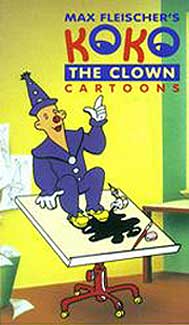

 The model complains when he realizes the bust looks just like him (he apparently wanted to look less ugly). Max says he'll be over to help "as soon as I put some energy in this clown." He draws skates on Koko's feet & a scene with a frozen pond.
The model complains when he realizes the bust looks just like him (he apparently wanted to look less ugly). Max says he'll be over to help "as soon as I put some energy in this clown." He draws skates on Koko's feet & a scene with a frozen pond.
 The dog Fitz gets dot-dot-dots from his eyes to a sign that reads alarmingly "Danger Beware Do Not Touch Earth Control. If this handle is pulled the world will come to an end." Fitz is eager to give it a try.
The dog Fitz gets dot-dot-dots from his eyes to a sign that reads alarmingly "Danger Beware Do Not Touch Earth Control. If this handle is pulled the world will come to an end." Fitz is eager to give it a try.



